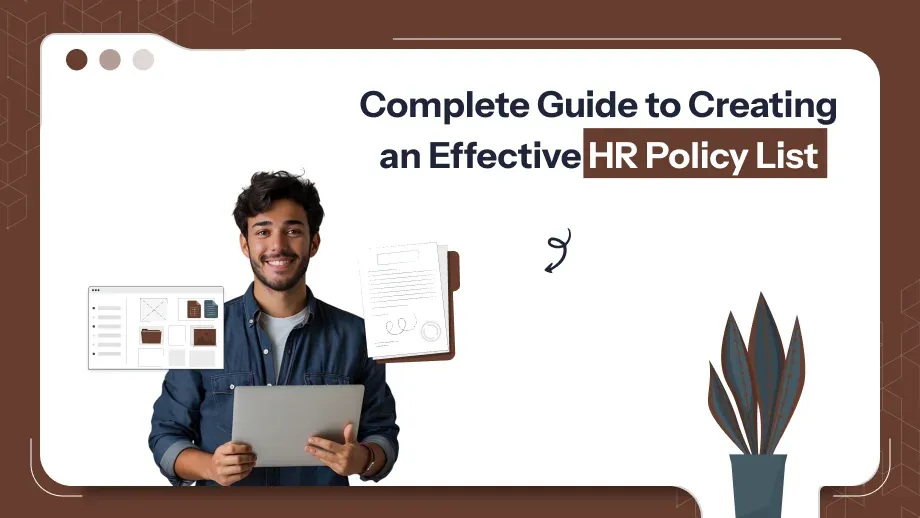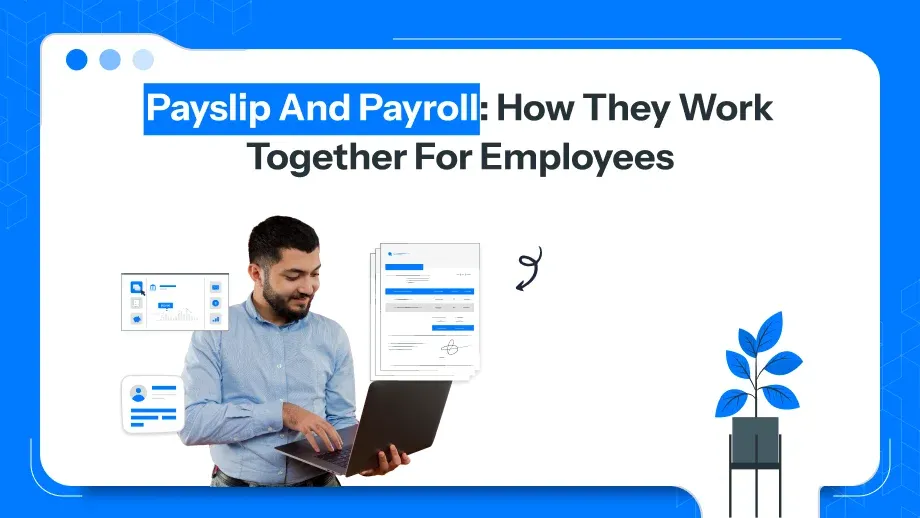
Human resource or HR, policies act as the guide or directing principle which organizations utilize to ensure proper handling of their employees. In short, HR policies would address an employee issue, help establish a definition of the company, and ensure adherence to all labor laws.
An HR policy list is a summary of all necessary policies included within the scope of an HR analyst. It represents an essential tool for consistency, transparency, and fairness within an organization.
What is an HR Policy?
A organized compilation of guidelines, norms, or procedures that govern the interaction between an organization and its staff is known as an HR policy. Nearly every topic is covered by HR rules, including hiring, pay, benefits, performance management, workplace conduct, safety and security, and well-being for workers.
In spite of ensuring that the regulations are fulfilled, these policies additionally help for keeping a productive workplace.In simple terms, an HR policy list is to enable an organization to clearly state the expectations from its employees; it sets out rights and responsibilities for both parties involved. It ensures a uniform way of addressing different issues in the cycle of employment.
Why are HR Policies and Procedures Important?
For a variety of reasons that ensure an organization’s success and efficient operation, human resources procedures and regulations are essential.
Fairness and Consistency:
Encouraging consistency in decision-making is one of the main advantages of HR rules. Companies may ensure that all employees receive equitable treatment during the hiring process, performance reviews, and disciplinary proceedings through putting written guidelines in place.
Legal Compliance:
HR procedures reduce the probability of legal issues by assisting firms in maintaining adherence to labor laws and regulations. While following wage and hour rules ensures that the company stays in compliance with state and federal standards, a clear harassment strategy can shield a business from future lawsuits.
HR policies communicate very clearly what the organization expects from an employee and vice versa. This way, misunderstandings and conflict reduce significantly, helping to make the workplace more efficient and effective.
Efficiency in Structure:
HR policies clearly organize how to take certain decisions regarding a particular event or incident, ensuring proper structure and a clear pathway for tackling such events. This creates efficiency among the HR workforce in dealing with employees throughout the employee cycle, right from induction till termination.
Employee Engagement and Retention:
A clear HR policy list or payroll policy also creates a positive culture in the workplace. With well-informed employees about their rights, benefits, and the stance of the company on many matters, they feel included and valued. This can then create loyalty and help avoid turnover.
How to Write an HR Policy List?
You really must, for once plan on writing an HR policy list, clarity and total comprehension of your organization needs should guide you. The next stages therefore involve the following in compiling the HR policy list.
Assess Your Organization’s Needs
This begins with determining the policies required by your business. The size of the company, its industry, and even some challenges in the specific industry would also be necessary to determine in this stage. Although the large corporation might require more detailed policies, small businesses could have core policies like recruitment, compensation, and employee behavior.
Study Relevant Laws and Regulations
HR policies must be in line with the local, state, and federal labor laws. It is essential to research labor regulations on areas such as EEO, workplace safety, employee rights, and wage laws, among others, to make sure that your policies are legally sound.
Develop the Policy Framework
Develop a template or framework for your HR policies. Each policy should include:
Policy Title: Clearly state the topic (e.g., Recruitment Policy, Health and Safety Policy).
Objective: The purpose of the policy.
Scope: A collection of people to which the policy will apply, including every staff member, supervisors, and subcontractors.
Definitions: Define any important terms to avoid confusion
Policy Statements: The regulations or regulations that employees must comply with.
Procedures: comprehensive guidance on how to carry up the policy.
Responsibilities: Fully define the responsibilities and duties that employees and managers have when implementing the policy in practice.
Keep the Language Clear and Concise
HR policies must be in plain, lucid words without ambiguity. Use easy, nontechnical language; avoid jargon and other highly technical terms as much as possible, for it only muddles employees and makes it a difficult follow-through than employees can use hrms software in india. Be professional, but accessible at the same time.
Stakeholder Consultation
It’s critical to meet with significant stakeholders, particularly managers, legal advisors, and HR personnel, prior to finalizing your list of HR policies. They can offer insightful criticism to make sure the policies satisfy legal deadlines and company goals.
Review and Update Regularly
HR policy list should to be evolving documents that face periodic evaluations and updates. It’s critical to update standards as the business develops and labor regulations change in want to be recent and compliant. Set a review schedule to guarantee that policies stay relevant.
What are HR Policy Examples?
Below are some of the essential HR policy examples that should form part of your HR policy list. These policies address most of the common areas of concern in most organizations.
Recruitment and Hiring Policy
Goal: To make sure a consistent and impartial hiring approach that draws in suitable candidates.
Important elements : It include the equal employment opportunity statement, interviews protocols, application manipulate, advertisement procedures, and selection standards.
For instance: All employment opportunities shall be posted internally for a minimum of five working days before being released openly. The hiring procedure is going to be open, fair, and determined by the qualifications, skills, and professional background of each applicant.
Leave and Attendance Policy
Goal: To manage punctuality and define employee rights for various forms of absence.
Essential components: It include paid time off, medical leave, paternity and maternity leave, statutory holidays, or leave applications.
For instance: workers are entitled to 10 days of compensated sick leave annually. The person in charge should be notified of any absences at least a day in advanced.
Compensation and Benefits Policy
Goal: Define benefit plans, incentives, and salary ranges.
Important elements: It include medical coverage, retirement applications, bonuses for performance, salary groups, and other incentive.
For instance: The company offers attractive salary packages, with yearly assessments based on individual as well as organizational achievement. After three months in employment, healthcare advantages are given to employee performance evaluation.
Harassment and Discrimination Policy
Goal: The aim is to eradicate discrimination and harassment at work and to provide an arbitration mechanism.
Important elements: It are the definition of harassment, procedures for reporting, the process of investigation, and punishments.
For instance: Any type of harassment—verbal or tangibleis completely forbidden. Any worker that feels mistreated should notify their supervisors or HR promptly.
Health and Safety Policy
Goal: The goal was to guarantee the security and well-being of workers in their place of employment.
Important elements : It include programs for wellness, emergency protocols, workplace safety policies, and health tests.
For instance: The company offers the required safety gear and instruction. Workers need to make sure that constantly abide by security rules and avoid accidents.
Termination and Resignation Policy
Goal: The goal is to describe the procedures for both voluntary and involuntary worker separations.
Important elements: it include the notice period, exit interview, resignation process, and the return to company property.
For instance: Before leaving, workers must provide no less than two weeks’ notice. An interview for exit will be carried out by the organization to gather feedback and facilitate an effortless transition.
HR Policies Impact on Organizational Culture
HR policies, which group norms, values, and behavior guidelines, are an important component for establishing the culture of an organization. By well communicated, clear policies, an organization can ensure that its expectations of employees are clearly set out, the manner to deal with colleagues, and what benefits are entitled for them.
Such clarity allows creating a healthy, productive working atmosphere in which employees feel respected and supported. Moreover, effective HR policies help minimize conflicts, reduce turnover, and promote trust between employees and management. They also help align employee performance evaluation with organizational objectives, ultimately contributing to the company’s success.
Conclusion
An HR policy list or hr payroll software is a must for every organization.It lays in how different HR-related duties are to be handled and guarantees that both sides are in agreement about rights, obligations, and expectations.
If HR rules are clear, succinct, and meet with the law, they lower legal risks, increase operational efficiency, and assist create a consistent, transparent, and employee-engagement-promoting work environment.





